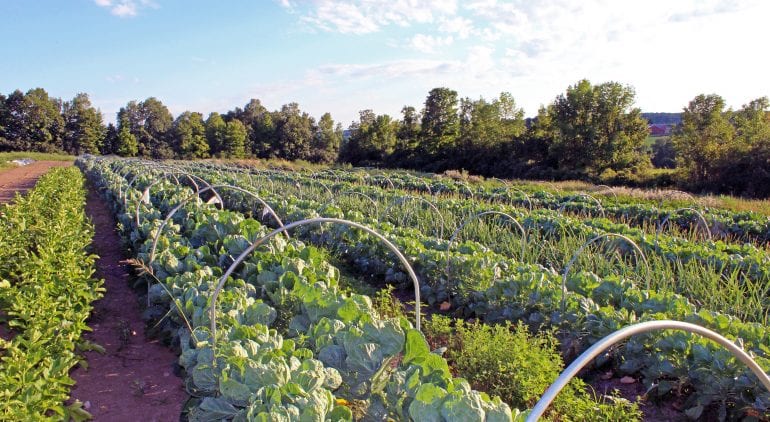
Vermont’s Local Food System: A Report Card – Part 1
At a recent meeting of the Addison County Hunger Council, three representatives offered interesting perspectives regarding Vermont’s local food system, and shared the successes and challenges associated with serving each particular group they represented. The Council explored issues throughout the local food system, from the farm workers who produce the food, to the distribution system for getting food to those who need it most. Council members discussed available resources, what supports are necessary, and what opportunities are present.
The representatives sharing presentations were Dr. Teresa Mares of UVM, Lily Bradburn of HOPE, and Jonathan Corcoran of ACORN. Dr. Mares shared insights about how our local food system serves the growing migrant farm worker population in Vermont. Lily Bradburn spoke about how these systems serve members of our community who are food insecure, and Jonathan Corcoran discussed local food system goals and challenges for our state as a whole. Here at the Co-op, we spend a lot of time thinking about local food and the systems that support it, though it was very interesting and unique to think of it though the lens of these diverse groups of people. If the function of a food system is to feed the community it supports, then we must assess its efficacy from the diverse viewpoints of all members of that community. Through a three-part review of these presentations, we hope to share what we learned with all of you. First up is the work of Dr. Teresa Mares.
Migrant Farm Workers & Their Families:
Dr. Teresa Mares and her assistant Jessie Mazar (University of Vermont) led the discussion about food security among our growing migrant farm worker population in Vermont. Teresa is a professor of Anthropology at UVM, and Jessie is a graduate student in Food Systems. They presented an overview of a research project they’ve been working on for the past 5 years. The project, which will be continuing for another few years, just finished its first phase, in which she and Jessie collected data on food insecurity and access to food through surveys with migrant farm workers.
Vermont is considered a “non-traditional destination” for migrant workers, but still has at least 1000 – 1200 migrant workers in the state. 90% of migrant workers are undocumented, so the exact number is unknown. Most are arriving from Mexico, though some come from countries in Central America. Most migrant workers are concentrated in Addison County and Franklin County, and many work on dairy farms. Vermont is the most dairy-dependent state in the country, and it’s estimated that between one-half and two-thirds of the state’s dairy products are prepared by migrant workers. Dairy work is considered very desirable, as it is consistent, year-round, and usually offers some form of housing. However, because it is year-round, there is no legal pathway to citizenship for workers.
Teresa and Jessie’s early conclusions show that a worker’s proximity to the US / Canada border has a strong effect on that person’s food security and access to resources. Teresa highlighted the physical location of two invisible lines: one was 25 miles from the US/Canada border and defines the “primary operating zone” for Border Patrol and Immigration Services (IS); the second was 100 miles from the border, in which land is still under the general jurisdiction of Border Patrol and IS, but sees much less activity. Addison County falls within this 100 mile border.
Overall, only 18% of migrant workers were found to be food insecure, which is close to the Vermont average, and much better than other states’ migrant populations. Nationally, migrant farm workers experience food insecurity at a rate that is roughly 3-4 times the national average (14%), so it’s reassuring to find that these families fare slightly better here in Vermont. The average in Franklin County was 18.2%, but in Addison County, migrant food insecurity was only 15.7%. Teresa linked this to the two different areas’ proximity to the US / Canada border. In Addison County, which is outside of the primary operating zone for IS and Border Patrol, migrant workers are much more likely to use driver permission cards, and much more likely to be traveling away from their farms in order to access food and other resources. However, in Franklin County, migrant workers were much more afraid to leave the farm, which has led to a lot of dependence on their employers or third parties to get food. This practice has been very exploitative in some places.
Jessie described the Huertas project being led by UVM Extension, which has helped demonstrate the incredible resiliency and creativity of accessing food by migrant workers. UVM Extension workers have helped provide seedlings of culturally appropriate plants and started gardens for migrant workers on farms. The program started in Addison County last year, and found that there were already strong networks of migrant workers in the region. Jessie described that many migrant workers already have farming backgrounds, and use the gardens to supplement their own food
over the summer months (as opposed to trying to scale up and create a market for their crops). The gardens also serve an important social and cultural role for the workers.
One interesting highlight was when Jessie mentioned the role of local co-ops in offering culturally meaningful foods for these families. She found during her interviews that migrant farm workers are often able to find culturally meaningful foods like masa, dried chiles, and corn husks for tamales at co-ops. She touched on the importance of providing access to these foods, as they can have an important influence on social and familial relationships. These foods allow migrant families to retain their cultural identity and maintain strong family and social bonds.
The Council discussed some of the political and logistical complications facing migrant workers and their families. Dr. Mares described the challenging hours facing dairy workers, who often work 70-80 hours/week from 4-11am and 4-11pm, which obviously affects their health and ability to cook. Middlebury Foods shared that they have been trying to connect their services to these families, and are in the early stages of trying to provide food pick-up sites in areas that are easily accessible for migrant farm workers. Dr. Mares and council member, Martha Kenfield, discussed that migrant families usually access school meals. Martha shared that if a parent identifies themselves as a migrant, it allows the family access to more resources at the school, but understood that revealing their status could be difficult. Cheryl Mitchell of NOFA- VT, who was part of a group that helped start the Latino Farmworker Coalition, praised the presentation and research. She is encouraged by the amount of energy emerging around supporting migrant workers, especially the Migrant Justice group and their Milk with Dignity program.
Dr. Mares’s work was enlightening and inspiring. It certainly identified areas for improvement with regard to our food system and the way it serves these members of our community, but also shed light on some very positive programs and components of our food system that are making food accessible for migrant farm workers and their families. As the population of migrant farm workers continues to grow in our county, what can we do to make our Co-op a more welcoming and accessible place for these community members?



